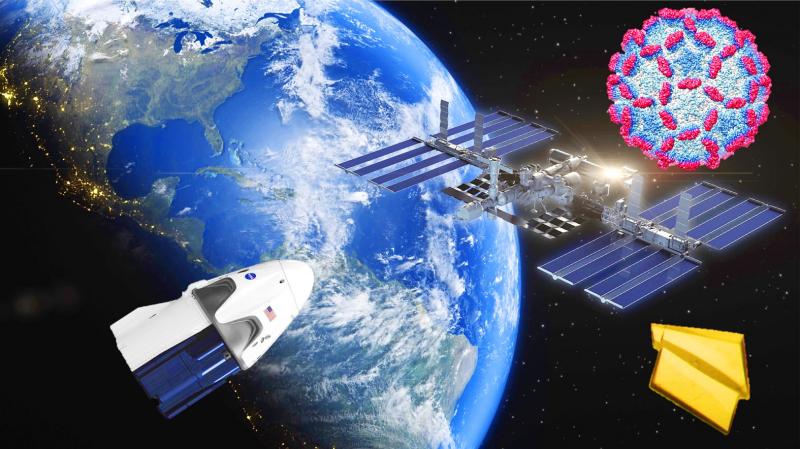A batch of virus-like particles cultivated by the National Synchrontron Radiation Research Center is to be sent to the International Space Station for crystallization experiments next month, in collaboration with Japanese company Space BD, the center announced yesterday.
Space BD in May said that it had been appointed as the sole private partner by the Japan Aerospace Exploration Agency (JAXA) for its high-quality protein crystal growth experiment service, HelioX Cosmos founder and CEO Bill Chang (張懷謙) said.
A parcel of the center’s particles has been sent to Japan for a US rocket launch scheduled next month, Chang said, adding that he could not reveal the precise time and rocket supplier for the mission.

Photo courtesy of the National Synchrotron Radiation Research Center
The particles are to stay in the space station’s lab for nearly a month, he said.
The launch is primarily a supply mission for the space station, the center said.
The particles are expected to crystallize while in space, and would be kept at minus-196°C after being returned to Earth, it said.
After the particles return to the center, researchers plan to utilize high-intensity X-ray and protein crystallography technology at the Taiwan Photon Source to observe changes in the particles, it said.
The particles originated from viruses that can cause diseases in humans or animals, and have been reduced to being “virus-like” after removal of their pathogenic genes, said center deputy director Chen Chun-jung (陳俊榮), who leads a team on molecular biology research.
While conducting postdoctoral research at the University of Georgia from 1999 to 2000, Chen engaged in a similar project in which particles were sent to space through a NASA-supported project, he said.
“We expect the quality of the particles’ crystallization to elevate significantly in a gravity-free environment, in comparison with that in general laboratories on Earth,” Chen said.
With better crystallization, researchers can analyze the viruses’ atomic structures with better depth and improve understanding about their pathogenic mechanisms, he said.
Although Chen did not state which types of viruses are being sent to the space station, the center’s news release referred to viruses that cause COVID-19, swine fever, avian influenza, and sealife diseases as examples that can claim lives and cause economic damage.
Improving our understanding about the viruses would help the development of new treatments, the center said, hoping to make breakthroughs in precision medicine and pandemic-prevention technology.
The center, headquartered at the Hsinchu science park, is affiliated with the Ministry of Science and Technology. The project has been coordinated by HelioX Cosmos, a Taiwanese start-up that is the official representative for the Japanese company.

The Ministry of Foreign Affairs (MOFA) yesterday voiced dissatisfaction with the Comprehensive and Progressive Agreement for Trans- Pacific Partnership (CPTPP), whose latest meeting, concluded earlier the same day, appeared not to address the country’s application. In a statement, MOFA said the CPTPP commission had "once again failed to fairly process Taiwan’s application," attributing the inaction to the bloc’s "succumbing to political pressure," without elaborating. Taiwan submitted its CPTPP application under the name "Separate Customs Territory of Taiwan, Penghu, Kinmen and Matsu" on Sept. 22, 2021 -- less than a week after China

ALIGNED THINKING: Taiwan and Japan have a mutual interest in trade, culture and engineering, and can work together for stability, Cho Jung-tai said Taiwan and Japan are two like-minded countries willing to work together to form a “safety barrier” in the Indo-Pacific region, Premier Cho Jung-tai (卓榮泰) yesterday said at the opening ceremony of the 35th Taiwan-Japan Modern Engineering and Technology Symposium in Taipei. Taiwan and Japan are close geographically and closer emotionally, he added. Citing the overflowing of a barrier lake in the Mataian River (馬太鞍溪) in September, Cho said the submersible water level sensors given by Japan during the disaster helped Taiwan monitor the lake’s water levels more accurately. Japan also provided a lot of vaccines early in the outbreak of the COVID-19 pandemic,

THE GOOD WORD: More than 100 colleges on both sides of the Pacific will work together to bring students to Taiwan so they can learn Mandarin where it is spoken A total of 102 universities from Taiwan and the US are collaborating in a push to promote Taiwan as the first-choice place to learn Mandarin, with seven Mandarin learning centers stood up in the US to train and support teachers, the Foundation for International Cooperation in Higher Education of Taiwan (FICHET) said. At the annual convention of the American Council on the Teaching of Foreign Languages held over the weekend in New Orleans, Louisiana, a Taiwan Pavilion was jointly run by 17 representative teams from the FICHET, the Overseas Community Affairs Council, the Steering Committee for the Test of Proficiency-Huayu, the

A home-style restaurant opened by a Taiwanese woman in Quezon City in Metro Manila has been featured in the first-ever Michelin Guide honoring exceptional restaurants in the Philippines. The restaurant, Fong Wei Wu (豐味屋), was one of 74 eateries to receive a “Michelin Selected” honor in the guide, while one restaurant received two Michelin stars, eight received one star and 25 were awarded a “Bib Gourmand.” The guide, which was limited to restaurants in Metro Manila and Cebu, was published on Oct. 30. In an interview, Feng Wei Wu’s owner and chef, Linda, said that as a restaurateur in her 60s, receiving an